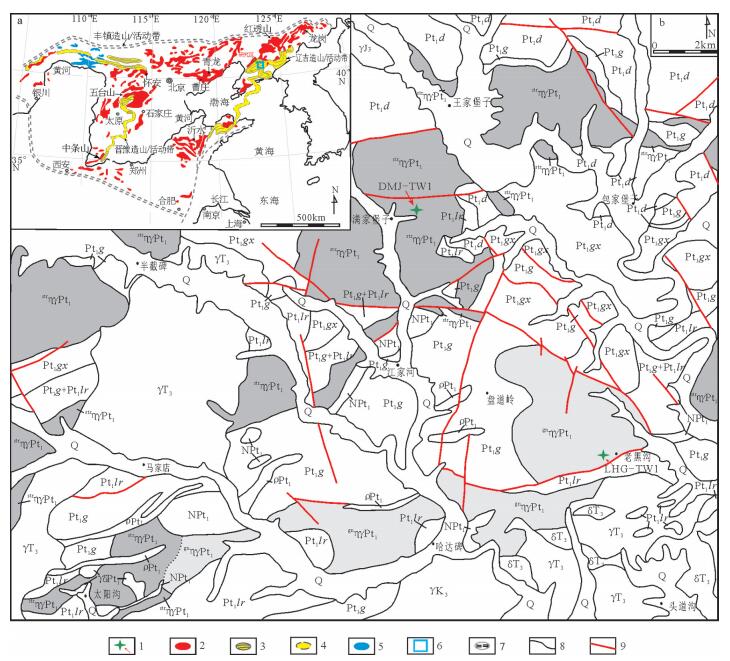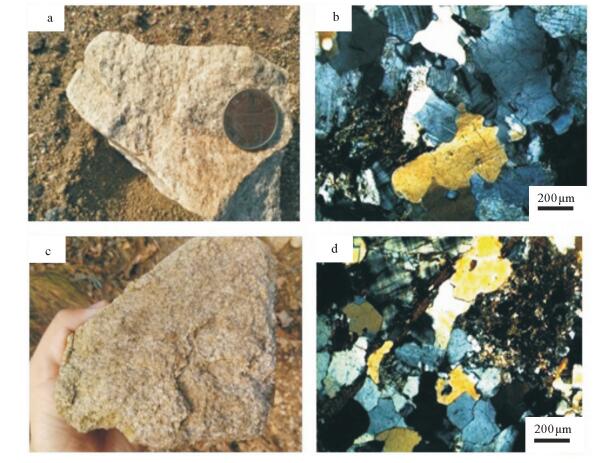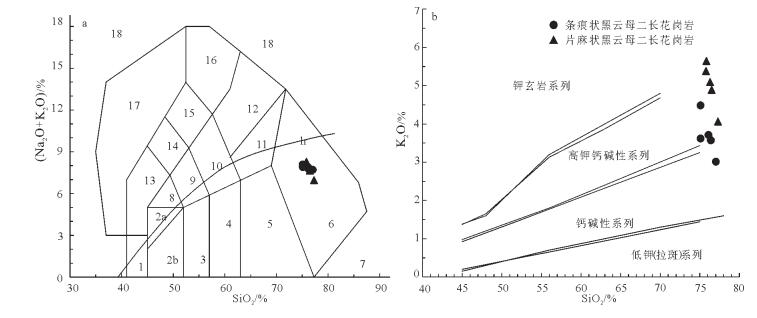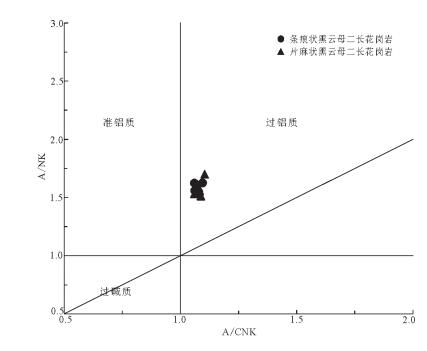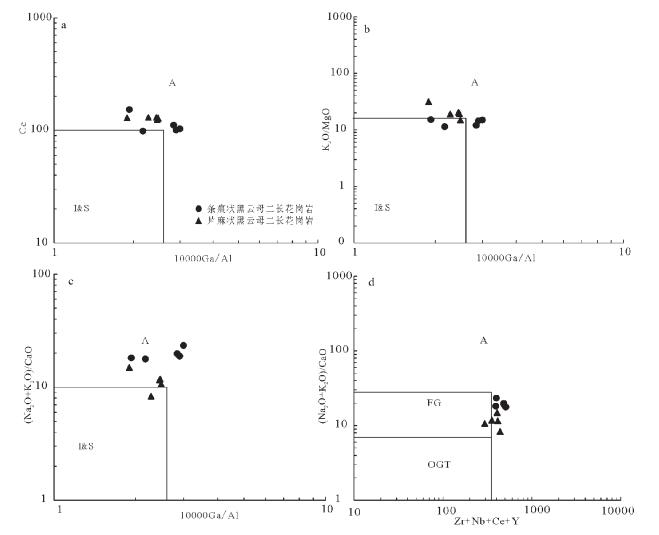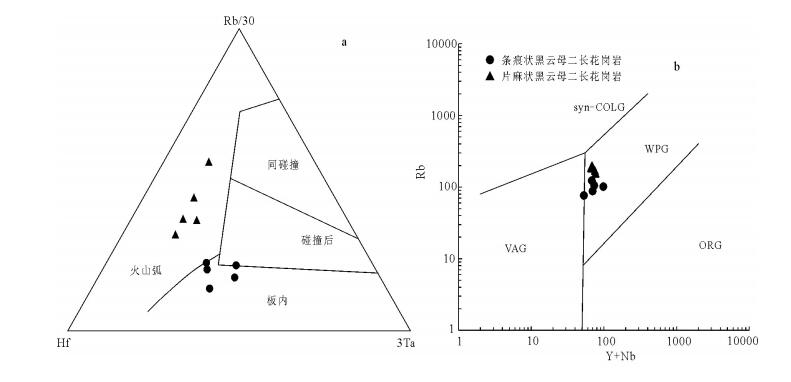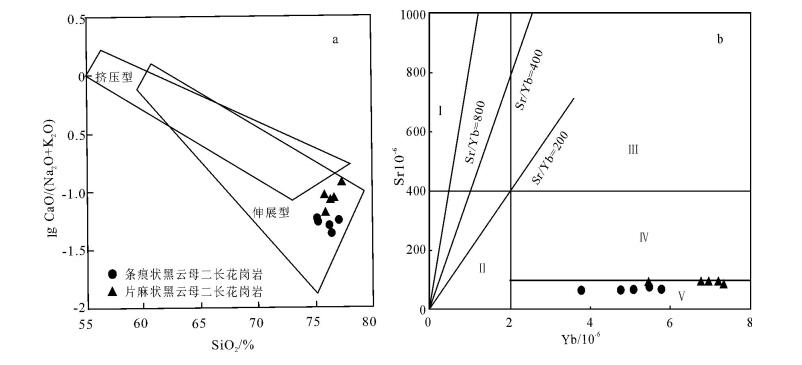Geochemistry and zircon U-Pb-Hf isotopes of Paleoproterozoic granitic rocks in Wangjiapuzi area, eastern Liaoning Province, and their geological significance
-
摘要:
辽东王家堡子地区出露大量古元古代花岗质岩石,前人将其统称为花岗质混杂岩。通过详细的野外地质调查和室内综合研究,将该套花岗质混杂岩解体为条痕状黑云母二长花岗岩和片麻状黑云母二长花岗岩两类。岩石地球化学分析结果显示二者具有一致的地球化学特征。均显示高SiO2、富K2O、贫Al2O3的特征,K2O/Na2O=0.64~2.14,TiO2含量为0.16%~0.3%,MnO、MgO、CaO和P2O5的含量较低,铝指数A/CNK集中分布在1.06~1.1之间,A/NK在1.50~1.62之间,均属于过铝质高钾钙碱性系列;微量元素显示强烈亏损Nb、Ti、Ta等高场强元素,富集Rb、U、K等大离子亲石元素,具有明显的负Eu异常,具有A型花岗岩的特征。条痕状黑云母二长花岗岩大部分锆石为具有清晰振荡环带的岩浆锆石,LA-ICP-MS锆石U-Pb年龄为2188±13Ma,代表该岩石的岩浆结晶年龄。片麻状黑云母二长花岗岩大部分锆石具有明显的变质增生边,部分核部锆石具有清晰的振荡环带,LA-ICP-MS锆石U-Pb测年获得核部年龄为2214±16Ma,代表该岩石的岩浆结晶年龄;增生边年龄为1905±13Ma,应代表该岩石的变质年龄。条痕状黑云母二长花岗岩和片麻状黑云母二长花岗岩的Hf同位素模式年龄分别为2387~2584Ma和2474~2641Ma,平均地壳模式年龄分别为2495~2808Ma和2633~2868Ma,大于岩石形成年龄,暗示研究区古元古代花岗岩源区主要为太古宙基底,混有少量古元古代新生地壳。结合前人报道的埃达克质花岗闪长岩的形成环境,认为胶-辽-吉古元古代造山/活动带早期经历了2.2~2.15Ga的拉伸裂解过程和2.0Ga左右俯冲挤压的构造演化过程。
-
关键词:
- 古元古代花岗岩 /
- LA-ICP-MS锆石U-Pb年龄 /
- Hf同位素 /
- 地球化学 /
- 辽东王家堡子地区
Abstract:Paleoproterozoic granites are widely distributed in the Wangjiapuzi area of eastern Liaoning Province. In the past, some granitic plutons were considered as granitic melange in this area. In this paper, the authors divided the granitic melange into two types, i.e., striate biotite monzogranites and gneissic biotite monzogranites, on the basis of comprehensive studies of field observation, petrography, geochemistry and isotope chronology. The results of geochemical analysis show that the two components are homogeneous, having uniform geochemical characteristics. They all show high SiO2\, rich K2O and poor Al2O3 features, with K2O/Na2O being 0.64~2.14. Their TiO2 values are between 0.16% and 0.3%, with lower MnO, MgO, CaO and P2O5 content. The saturation index A/CNK is between 1.06 and 1.1, and A/NK is between 1.50 and 1.62, which suggests that the granodiorites should belong to the peraluminum calcium alkaline series. Some trace elements show that high field strength elements such as Nb, Ti, Ta are strongly depleted, with an obvious anomaly of negative Eu. All the geochemical characteristics suggest that they should belong to Atype granites.The most zircon grains of striate biotite monzogranites show clear oscillating zoning structures, and LA-ICP-MS zircon U-Pb weighted mean age is 2188±13Ma(MSWD=0.49), with the age of magma crystallization representing the age of the rock. The most zircons of gneissic biotite monzogranites show obvious metamorphic edge, zircons from the part of the nucleus show clear oscillating zoning structures. LA-ICP-MS nucleus zircon U-Pb weighted mean age is 2214±16Ma(MSWD=1.01), with the age of magma crystallization representing the age of the rock. LA-ICP-MS edge zircon U-Pb weighted mean age is 1905±13Ma(MSWD=4.5), representing the age of metamorphic rock. The model ages of these two types of granites obtained from Hf isotope are respectively 2387~2584Ma and 2474~2641Ma, the average of the crustal pattern is 2495~2808Ma and 2633~2868Ma, older than the age of rock formation. The source area of Paleoproterozoic granite in the study area was mainly Archean basement mixed with a small amount of Paleozoic Neoproterozoic crust. The formation environment of the dike granite diorite is reported by some geologists. It is shown that the early rising of the Jiao-Liao-Ji orogenic/activity belts experienced a tensile cracking process at about 2.2~2.15Ga, and then there was a process of subduction and compression around 2.0Ga.
-
榴辉岩作为一种高压-超高压成因的岩石,历来被广为关注。早年Eskola[1]建立了榴辉岩相,认为其主要由绿辉石和石榴子石组成,形成压力大于1GPa,Carswell等[2]将其定义为经高压变质作用,快速折返到地表形成的一种特殊岩石。20世纪90年代以来,在青藏高原及其周边陆续发现了一些榴辉岩,对其岩石性质及折返模式进行研究[3-13],为中国西部构造演化,特别是中央造山带的构造演化提供了有力的证据[11-17]。西北地区先后在阿尔金、北祁连、西南天山、柴北缘发现了加里东期榴辉岩[6, 8, 14, 18-20]。近年,祁生胜等[3]在东昆仑西段东昆北地块夏日哈木-苏海图一带,Meng等[4]在东昆仑东段东昆中断裂带附近温泉一带发现形成于加里东期的榴辉岩[3-4],这些榴辉岩与笔者在东昆仑东段浪木日上游发现的早古生代榴辉岩大地构造位置相似。该榴辉岩是否与前两者具有可对比性,能否恢复一条高压变质带?针对以上问题,本文拟展开年代学等方面的研究。
东昆仑造山带作为中央造山带重要的部分,历来是地质学家研究的热点[21-26]。近年来在东昆仑地区开展了大量不同比例尺的区域地质调查和综合研究项目[27]①②③,众多学者认为,东昆中构造混杂岩带是一条重要的构造缝合带[26-29],并获得了大量蛇绿岩、混杂岩带、侵入岩等基础性研究成果[25, 27]。根据亚东-格尔木-额济那旗等地学断面的研究结果[30-31],昆中断裂是一条规模巨大的深断裂,而岩石圈尺度三维不连续面的再活化是大陆内部成矿带的有利储矿空间[32]。因此,东昆仑造山带内部,尤其是昆中断裂带附近具有极大的找矿潜力。再者,昆仑山-柴达木作为造山带内部相对稳定的地块,推测地表下35~45km麻粒岩相岩石构成的加厚地壳下部有基性榴辉岩相岩石组成的上地幔分布[33-34],而具有高压成因的榴辉岩已出露到东昆北构造带中,是上地幔物质在地表的显示,为探讨中国西部岩石圈构造演化历史和寻找与超高压作用有关的矿产提供了宝贵的资料。
2013年起,笔者等在东昆仑开展了中国地质调查局青海省都兰县1:5万沟里乡-热水乡地区卡鲁幅区域地质调查项目,在东昆仑东段昆中断裂以北的郎木日上游昆北变质基底中发现大量新鲜榴辉岩和已发生退变质的榴闪岩,经过系统的野外调研,对榴辉岩的产状、类型及分布特征进行了详细研究,确定东昆仑造山带东段昆北构造带内部存在未发生退变质的榴辉岩,沿浪木日上游近300°走向断续延伸长达18km,为获得榴辉岩变质峰值时代及原岩年龄信息,对其进行LA-ICP-MS锆石U-Pb测年,结合区域地质背景,推测其形成可能与东昆仑造山带加里东期板块俯冲碰撞有关,并在研究区及东昆仑东段形成了大规模的构造岩浆事件[35-36]。这一成果对深入探索东昆仑造山带构造演化具有重要意义。
1. 区域地质背景
中央造山系横亘于中国大陆中部,是由中国南、北两大陆块拼合形成的巨型构造带[37-40],研究区位于中央造山系西部东昆仑造山带的东段,同样也是东昆仑造山带、秦岭造山带、柴达木地块、巴颜喀拉造山带的构造交接区域,是研究秦祁昆造山系构造交接关系和构造演化过程的重点区域。东昆仑造山带以东昆中断裂带为界,可划分为东昆北构造带、东昆南构造带,近年来将东昆北构造带以昆北断裂为界分为祁漫塔格、昆北2个构造单元,从而将东昆仑分为祁漫塔格地块、昆北构造带、昆南构造带3个构造单元[21-22, 27, 41],不同构造单元的名称不同,但划分方案和边界基本类似,其中昆北构造带实际为一基底隆起-花岗岩带,变质基底集中分布[37]。东昆仑造山带演化不是一个简单的俯冲碰撞增生过程,其具多旋回复杂演化历史,经历过多旋回的洋陆转化,碰撞后的陆内演化也很复杂[26-27, 41]。其中昆中断裂以北的昆北构造带以古元古界白沙河岩组为结晶基底,被称为硬基底或刚性基底[41],带内不同期次的花岗岩极为发育,近年来,区域地质调查表明,主体为奥陶纪-泥盆纪花岗岩和晚二叠世-晚三叠世花岗岩,2个不同旋回的花岗岩分布面积相近[3]。
研究区(图 1)构造划分隶属于东昆北构造带[23],出露地层复杂,发育多期次韧性剪切断裂及脆性断裂,岩浆活动极为发育。出露地层有古元古界白沙河岩组、中元古界小庙岩组中深变质基底岩系、下古生界纳赤台群、泥盆系契盖苏组、三叠系鄂拉山组等。其中,古元古界白沙河岩组变质程度以角闪岩相为主,局部出现麻粒岩相变质,岩石类型以角闪斜长片麻岩、黑云斜长片麻岩、斜长角闪岩、黑云石英片岩、二云石英片岩、大理岩等为主,夹含蓝晶石榴二云石英片岩、蓝晶石榴黑云石英片岩,局部有榴辉岩、榴闪岩、超基性岩等构造透镜体,岩石中面理置换强烈,尖棱褶皱、无根勾状褶皱等塑性流变普遍发育,S0被置换为S1-Sn。晋宁期、加里东期、印支期不同规模、不同类型的构造-岩浆活动分布广泛。调查发现,基底岩系面理产状多为高角度北倾,韧性构造变形较发育,糜棱岩、糜棱岩化岩石亦有发育,其糜棱面理产状与区域面理产状近于一致,糜棱岩化岩石中见有拉伸线理、σ型旋转碎斑系、SC组构等指向构造,多指示具左旋斜冲特征,局部有少量右旋逆冲特征。
2. 榴辉岩地质特征
新发现的榴辉岩大地构造位置位于东昆仑造山带东段东昆北构造带内,地理位置位于青海省都兰县热水乡浪木日上游-尕之麻一带,呈不同大小的构造块体散布于古元古界白沙河岩组及新元古代花岗质片麻岩中,近东西向断续出露长约18km,宽1~3km,构成一条高压变质带(图 2)。带内榴辉岩绝大多数透镜体呈串珠状出现,个别呈独立的透镜体出现(图 3-a),与围岩呈断层接触,长轴走向约300°,与高压带走向近于一致,平面上大小1×0.5m2~50× 14m2不等。围岩为元古宙不同地质体,包括古元古界白沙河岩组中深副变质岩与新元古代花岗片麻岩,副变质岩主要为黑云石英片岩、黑云斜长片麻岩、大理岩等。在与大理岩接触时,二者接触界线模糊,局部互为透镜体,高压带内围岩多发育糜棱岩化现象。部分榴辉岩透镜体内发育碎裂岩化,石英脉穿插发育(图 3-b),将榴辉岩切割成碎块,石英脉与榴辉岩接触界线截然,宽度5~20cm不等,在榴辉岩与围岩接触部位,也可见石英细脉。
3. 榴辉岩岩石学与矿物学特征
3.1 榴辉岩岩石学特征
研究区内发现的榴辉岩大部分较新鲜,蚀变较弱,具有典型的石榴子石+绿辉石+石英+金红石岩石组合,部分榴辉岩发生部分退变质,使石榴子石形成肉眼可见的宽0.5~1.5mm不等的“白眼圈”结构,部分退变质较彻底,岩性为榴闪岩。
榴辉岩:呈灰绿色,粒状变晶结构,块状、平行定向构造(图版Ⅰ-a),岩石由绿辉石(40%~41%)、石榴子石(36%~37%)、石英(6%)、斜长石(4%)、角闪石(4%)、金红石(5%)、不透明矿物(3%)组成。绿辉石呈粒状-短柱状变晶,边界平直,节理清晰,粒径0.7~1.8mm,与石榴子石呈粒状镶嵌平衡结构(图版Ⅰ-b),绿辉石中含有金红石、石榴子石等包裹体(图版Ⅰ-c)。石榴子石呈不规则多边形粒状变晶,未见环带结构,粒径0.35~2mm,晶体中亦可见金红石、绿辉石、不透明矿物、石英等包裹体,部分石榴子石多发生次生变质,形成变余石榴子石(图版Ⅰ-d),边部常见阳起石(图版Ⅰ-e)。石英呈他形粒状变晶,具不规则裂纹和波状消光,与其他矿物呈镶嵌结构。各矿物均呈变晶致密状。
榴闪岩:呈深灰绿色,粒状变晶结构,平行定向-块状构造,矿物变晶较细,由石榴子石(12%~13%)、石榴子石假象(由斜长石、阳起石和普通角闪石组成的集合体)(16%~17%)、角闪石(49~51%)、绿辉石(3%~10%)、透辉石(5%~6%)、斜长石(大部分为钠长石,含量约占岩石的9%~10%)、金属矿物(2%)、金红石(1%~2%)组成。石榴子石呈混圆状,部分石榴子石发生退变质,周围可见由阳起石等组成的“白眼圈”结构;绿辉石呈淡绿色,颗粒大小0.2~1mm,绝大部分发生退变质,呈残留状分布在角闪石集合体中,通过电子探针能谱散射图(图版Ⅰ-f)研究发现,退变质后的绿辉石形成透辉石+钠长石组合,二者紧密共生,与薄片鉴定结果一致;角闪石为次生半自形,粒径大小0.5~1.5mm,呈不规则状;金红石多以包裹体形式存在于石榴子石、绿辉石及两者退变质矿物中。
3.2 榴辉岩矿物学特征
样品在长安大学西部矿产资源与地质工程教育部重点实验室采用JXI8100型电子探针完成,电压15kV,电子束流1×10-8,电子束半径1μm。
据矿物学研究确定,榴辉岩的变质矿物组合为石榴子石+绿辉石+金红石+石英;榴闪岩的退变质矿物组合为角闪石+阳起石+斜长石+透辉石。早期石榴子石多数被显微指纹状绿色阳起石和斜长石集合体组成的后合成冠状体或集合体取代,故榴辉岩至少经历了榴辉岩相变质与退变质2期变质作用过程。早期榴辉岩相变质,特征变质矿物组合为石榴子石+绿辉石+金红石+石英,形成榴辉岩;后期经历不同程度的角闪岩相退变,形成发育普通角闪石+斜长石+透辉石组合的榴闪岩,石榴子石多具后合成晶环带,甚至呈假象分布,绿辉石大部分发生较完全的退变。
根据电子探针测试的矿物成分(表 1)计算,榴辉岩及榴闪岩中的12颗石榴子石成分为Alm57-60Spess0.23-0.30Gross24-25Pyr16-18,其中镁铝榴石(Pyrope)含量小于35mol%,在石榴子石Alm + Spess-Pyr-Gross三角图解[42]中落入C型榴辉岩区(图 4)。榴辉岩中9个绿辉石的Na2O含量为5.43%~6.03%,经计算,其中硬玉分子含量为43.9mol%~45.9mol%,在榴辉岩中绿辉石成分图解[43](图 5)中位于绿辉石区,表明属较典型的绿辉石。利用石榴子石-单斜辉石温度计[44-46]和绿辉石中硬玉Jd组分温度计[47]联合估算(T,p),发现当压力在1.8~2.0GPa时,温度范围一致,为650~750℃,故浪木日上游榴辉岩形成温压条件为p=1.8~2.0GPa,T=650~750℃,为高压中温榴辉岩[2]。由于样品中未发现多硅白云母及蓝晶石,通过绿辉石中硬玉组分-石榴子石测出的峰期压力应只是一个最小值[4],因此得出的压力值应该高于1.8~2.0GPa。
表 1 榴辉岩中绿辉石、石榴子石的成分Table 1. Chemistry of omphacite and garnet in eclogites序号 1.1 1.2 1.3 1.4 1.5 1.6 1.7 1.8 1.9 2.0 2.1 2.2 2.3 2.4 2.5 2.6 2.7 2.8 2.9 3.0 3.1 矿物 石榴子石 绿辉石 SiO2 55.63 55.78 56.72 55.92 56.09 56.62 56.59 56.53 56.32 37.63 38.64 38.43 38.55 38.68 38.20 38.44 38.65 38.47 38.45 38.39 38.01 T1O2 0.163 0.209 0.145 0.162 0.048 0.178 0.155 0.194 0.190 0.030 0.094 0.034 0.095 0.108 0.070 0.065 0.131 0.105 0.088 0.101 0.076 MnO 0 0.027 0.061 0.050 0.017 0.056 0.023 0.031 0.002 0.572 0.563 0.594 0.549 0.618 0.626 0.497 0.621 0.520 0.522 0.605 0.473 Al2O3 10.29 10.27 10.93 10.35 10.51 10.89 10.83 10.75 10.85 21.14 21.38 21.43 21.55 21.19 21.58 21.52 21.67 21.12 21.21 21.55 20.96 FeO 6.185 6.221 6.177 6.268 6.096 6.453 5.928 6.123 5.922 26.89 27.67 27.63 27.15 27.67 27.85 27.08 27.12 26.78 26.78 27.81 27.14 CaO 12.54 12.60 12.35 12.55 12.63 12.90 12.25 12.62 12.66 8.683 8.536 8.512 8.410 8.644 8.495 8.513 8.532 8.628 8.770 8.347 8.477 MgO 7.548 7.676 7.036 7.347 7.208 7.199 7.386 7.305 7.234 4.224 4.388 4.260 4.315 4.506 4.197 4.475 4.507 4.431 4.496 4.171 4.322 K2O 0.008 0 0 0.014 0 0 0.022 0.023 0.019 0.004 0 0.015 0.012 0 0 0 0 0.005 0.004 0 0 Na2O 5.553 5.433 6.011 5.726 5.656 5.969 5.848 5.732 6.032 0.023 0.032 0.034 0.019 0.025 0.023 0.051 0.040 0.043 0.040 0 0.044 Cr2O3 0.012 0.032 0.012 0.022 0 0 0 0 0.037 0.055 0.016 0.023 0.009 0.034 0 0 0 0 0 0.014 0.044 SrO 0.202 0.124 0.247 0.181 0.166 0.178 0.165 0.180 0.151 0.092 0.109 0.094 0.080 0.069 0.121 0.110 0.059 0.150 0.081 0.176 0.035 Total 98.14 98.36 99.69 98.59 98.42 100.4 99.20 99.48 99.42 99.34 101.4 101.1 100.7 101.6 101.2 100.7 101.3 100.3 100.4 101.2 99.59 O 6.000 6.000 6.000 6.000 6.000 6.000 6.000 6.000 6.000 12.00 12.00 12.00 12.00 12.00 12.00 12.00 12.00 12.00 12.00 12.00 12.00 Si 2.048 2.050 2.054 2.049 2.059 2.036 2.057 2.053 2.041 2.972 2.991 2.986 3.002 2.990 2.968 2.990 2.989 3.008 2.999 2.985 2.995 Ti 0.005 0.006 0.004 0.004 0.001 0.005 0.004 0.005 0.005 0.002 0.005 0.002 0.006 0.006 0.004 0.004 0.008 0.006 0.005 0.006 0.005 Mn 0 0.001 0.002 0.002 0.001 0.002 0.001 0.001 0 0.038 0.037 0.039 0.036 0.040 0.041 0.033 0.041 0.034 0.034 0.040 0.032 Al 0.446 0.445 0.467 0.447 0.455 0.462 0.464 0.460 0.463 1.967 1.951 1.963 1.977 1.931 1.976 1.972 1.974 1.947 1.950 1.974 1.946 Fe3+ 0.037 0.030 0.055 0.049 0.063 0.016 0.055 0.040 0.031 0.085 0.061 0.066 0.011 0.079 0.084 0.049 0.039 0.032 0.049 0.044 0.059 Fe2+ 0.153 0.161 0.132 0.143 0.124 0.178 0.126 0.146 0.148 1.692 1.731 1.730 1.757 1.710 1.725 1.712 1.715 1.719 1.698 1.764 1.730 Ca 0.495 0.496 0.479 0.493 0.497 0.497 0.477 0.491 0.491 0.735 0.708 0.709 0.702 0.716 0.707 0.709 0.707 0.723 0.733 0.695 0.716 Mg 0.414 0.421 0.380 0.401 0.394 0.386 0.400 0.395 0.391 0.497 0.506 0.493 0.501 0.519 0.486 0.519 0.520 0.517 0.523 0.483 0.508 K 0 0 0 0.001 0 0 0.001 0.001 0.001 0 0 0.001 0.001 0 0 0 0 0 0 0 0 Na 0.396 0.387 0.422 0.407 0.403 0.416 0.412 0.404 0.424 0.004 0.005 0.005 0.003 0.004 0.003 0.008 0.006 0.007 0.006 0 0.007 Cr 0 0.001 0 0.001 0 0 0 0 0.001 0.003 0.001 0.001 0.001 0.002 0 0 0 0 0 0.001 0.003 Sr 0.004 0.003 0.005 0.004 0.004 0.004 0.003 0.004 0.003 0.004 0.005 0.004 0.004 0.003 0.005 0.005 0.003 0.007 0.004 0.008 0.002 cations 4.000 4.000 4.000 4.000 4.000 4.000 4.000 4.000 4.000 8.000 8.000 8.000 8.000 8.000 8.000 8.000 8.000 8.000 8.000 8.000 8.000 ![]() 图 4 榴辉岩中石榴子石成分图解[42]Alm-铁铝榴石;Spess-锰铝榴石;Gross-钙铝榴石;Pyrope-镁铝榴石Figure 4. Composition of garnets in eclogites
图 4 榴辉岩中石榴子石成分图解[42]Alm-铁铝榴石;Spess-锰铝榴石;Gross-钙铝榴石;Pyrope-镁铝榴石Figure 4. Composition of garnets in eclogites4. 榴辉岩锆石U-Pb同位素年龄
为了获得浪木日上游榴辉岩变质峰值年龄及原岩时代信息,采用LA-ICP-MS方法对榴辉岩锆石进行了U-Pb同位素测试。样品采自浪木日上游尕之麻一带,地理坐标为北纬35°43′3.15″、东经98° 42′23.85″,样品编号为D1817/1。将采得的新鲜榴辉岩样品送至廊坊诚信地质科技有限公司选矿室挑选锆石,从约15kg新鲜岩石样品中分离得到。分离出来的锆石在双目镜下挑出透明度好、无包体、无裂隙的颗粒,用无色透明的环氧树脂固定,待环氧树脂充分固化后,对其表面进行抛光,至锆石颗粒1/2出露;然后在长安大学西部矿产资源与地质工程教育部重点实验室扫描电镜加载阴极发光仪上完成阴极发光(CL)照相,在西北大学大陆动力学国家重点实验室完成LA-ICP-MS同位素分析。LA-ICP-MS分析在Hewlett Packard公司最新一代带有Shield Torch的Agilient 7500a ICP-MS和德国Lambda Physik公司的ComPex102 Excimer激光器(工作物质ArF,波长193nm)及MicroLas公司的Ge-oLas 200M光学系统联机上进行,锆石U-Pb同位素测定的激光束斑直径为30μm,激光剥蚀样品的深度为20~40μm。实验中采用氦作为剥蚀物质的载气,用美国国家标准技术研究院研制的人工合成硅酸盐玻璃标准参考物质NIST SRM610进行仪器最佳化,锆石年龄采用国际标准锆石91500作为外标标准物质,元素含量采用NIST SRM610作为外标,29Si作为内标元素进行校正。样品的同位素比值和元素含量数据处理采用Glitter(ver4.0, Macquarie University)程序,并采用Anderson[48]软件对测试数据进行普通铅校正,年龄计算及谐和图绘制采用Isoplot(2.49版)[49]软件完成。详细的实验原理、流程及仪器见参考文献[50-52]。
锆石的反射光照片可见,榴辉岩样品中的锆石多呈不规则-浑圆状晶体,显微镜下呈无色-淡黄色,颗粒大小在80~150μm之间。锆石透射光照片显示(图 6),绝大多数锆石见浑圆状的包裹体,大小为10~20μm,成分未知,部分锆石裂纹发育。阴极发光(CL)图像(图 6)显示,部分锆石保留有残核,锆石颗粒间明暗强度有变化,个别锆石边部见较亮的次生边,推测为后期热蚀变所致。为得到精确年龄信息,测试点均避开包裹体及裂纹。锆石内部环带不明显或有弱的环带,大多具有扇形分带或“杉树叶”结构,为典型的变质锆石特征[53-54]。
本次共测试31个点,根据年龄可分为2组,第一组7个点,分别为2、8、14、19、27、28、30号点,位置位于锆石核部或次核部,CL图像显示其可能为变质残核,U含量为120.27×10-6~278.78×10-6,平均为175.41×10-6,Th为13.25×10-6~25.97×10-6,平均为18.04×10-6,Th/U值在0.09~0.12之间,平均为0.105(表 2),为典型的变质成因锆石[53-54]。206Pb/238U与207Pb/235U谐和年龄(图 7)为487±5.9Ma(MSWD=0.17),206Pb/238U直方年龄为486±12Ma(MSWD=0.0066),二者在误差范围内一致,可能为原岩在板块俯冲过程中受构造热事件影响发生变质的记录;第二组共24个点,U含量为129.59 × 10-6~582.19×10-6,平均为287.07×10-6,Th为14.42×10-6~42.64×10-6,平均为28.2×10-6,Th/U值在0.06~0.14之间,平均为0.1007(表 2),206Pb/238U与207Pb/235U谐和年龄为431.9±2.3Ma(MSWD=2),206Pb/238U直方年龄为432.1±4.5Ma(MSWD=0.0074),二者在误差范围内近于一致。据研究,变质重结晶锆石具有较低的Th/U值,且变质重结晶作用越强,变质重结晶锆石的Th/U值越低[55],因此,那些Th/U值最低、年龄值最小的测点年龄加权平均值才能代表锆石重结晶作用发生的时间[56],故第二组年龄代表了重结晶作用最强的发生时间。榴辉岩的形成温度为650~750℃,与锆石U-Pb的封闭温度[57]基本一致,故该年龄代表榴辉岩锆石变质峰值年龄,变质峰值年龄为431.9±2.3Ma,时代为早志留世晚期。
表 2 榴辉岩(D1817/1)LA-ICP-MS锆石U-Th-Pb分析数据Table 2. LA-ICP-MS U-Th-Pb data of zircons from eclogite (D1817/1)分析 206Pb 232Th 238U Th/U 同位素比值 年龄/Ma 点位 含量/10-6 207Pb/206Pb 1σ 207Pb/235U 1σ 206Pb/238U 1σ 208Pb/232Th 1σ 207Pb/206Pb 1σ 207Pb/235U 1σ 206Pb/238U 1σ 01 96.6 41.5 324.6 0.128 0.0558 0.0032 0.5336 0.0303 0.0694 0.0019 0.0218 0.0014 443 122 434 20 432 11 02 54.1 16.6 160.9 0.103 0.0567 0.0048 0.6128 0.0516 0.0784 0.0025 0.0738 0.0051 479 179 485 33 487 15 03 92.0 22.5 312.1 0.072 0.0562 0.0045 0.5326 0.0419 0.0688 0.0021 0.0213 0.0026 459 168 434 28 429 13 04 100.4 27.2 337.4 0.081 0.0559 0.0020 0.5342 0.0196 0.0693 0.0017 0.0226 0.0011 446 77 435 13 432 10 05 88.8 39.6 297.8 0.133 0.0557 0.0023 0.5334 0.0221 0.0695 0.0017 0.0226 0.0010 439 88 434 15 433 10 06 78.5 27.7 264.2 0.105 0.0556 0.0035 0.5302 0.0334 0.0692 0.0019 0.0212 0.0018 434 135 432 22 431 12 07 73.7 28.1 247.1 0.114 0.0555 0.0033 0.5321 0.0312 0.0695 0.0019 0.0257 0.0017 433 126 433 21 433 11 08 40.3 13.3 120.3 0.110 0.0570 0.0066 0.6127 0.0701 0.0780 0.0029 0.0168 0.0029 489 239 485 44 484 17 09 94.3 34.2 316.6 0.108 0.0564 0.0034 0.5396 0.0321 0.0693 0.0019 0.0175 0.0014 469 128 438 21 432 11 10 43.6 15.2 146.5 0.104 0.0558 0.0064 0.5330 0.0600 0.0692 0.0025 0.0298 0.0038 445 237 434 40 432 15 11 97.5 25.9 327.3 0.079 0.0562 0.0030 0.5369 0.0288 0.0693 0.0018 0.0200 0.0016 458 115 436 19 432 11 12 95.3 29.8 321.0 0.093 0.0568 0.0029 0.5407 0.0280 0.0691 0.0018 0.0253 0.0016 481 111 439 18 431 11 13 81.7 26.6 274.4 0.097 0.0553 0.0022 0.5284 0.0211 0.0693 0.0017 0.0243 0.0011 426 85 431 14 432 10 14 62.8 20.0 186.3 0.108 0.0564 0.0049 0.6102 0.0523 0.0784 0.0025 0.0291 0.0030 469 183 484 33 487 15 15 78.7 22.7 262.8 0.086 0.0561 0.0053 0.5385 0.0499 0.0696 0.0023 0.0235 0.0030 457 196 437 33 434 14 16 41.8 14.4 140.2 0.103 0.0556 0.0033 0.5305 0.0315 0.0692 0.0019 0.0245 0.0018 436 128 432 21 431 11 17 76.1 22.9 254.4 0.090 0.0553 0.0022 0.5303 0.0217 0.0695 0.0017 0.0236 0.0012 425 87 432 14 433 10 18 75.6 32.5 253.1 0.128 0.0554 0.0049 0.5303 0.0458 0.0694 0.0022 0.0264 0.0024 428 185 432 30 433 13 19 40.5 14.9 120.3 0.124 0.0562 0.0068 0.6066 0.0722 0.0782 0.0029 0.0284 0.0038 461 249 481 46 486 18 20 75.2 20.8 252.0 0.082 0.0565 0.0027 0.5402 0.0256 0.0693 0.0018 0.0257 0.0016 473 101 439 17 432 11 21 38.7 14.5 129.6 0.112 0.0562 0.0035 0.5379 0.0333 0.0694 0.0019 0.0258 0.0018 460 133 437 22 432 11 22 94.0 42.6 315.2 0.135 0.0555 0.0030 0.5296 0.0287 0.0692 0.0018 0.0220 0.0013 432 117 432 19 431 11 23 92.3 33.4 308.0 0.108 0.0561 0.0035 0.5374 0.0336 0.0695 0.0019 0.0257 0.0018 455 134 437 22 433 11 24 45.7 14.5 152.7 0.095 0.0565 0.0056 0.5405 0.0530 0.0695 0.0023 0.0143 0.0023 469 208 439 35 433 14 25 139.0 28.0 464.9 0.060 0.0573 0.0023 0.5485 0.0223 0.0694 0.0017 0.0262 0.0015 504 86 444 15 432 10 26 100.6 38.2 336.0 0.114 0.0568 0.0032 0.5441 0.0307 0.0694 0.0018 0.0205 0.0014 485 121 441 20 433 11 27 65.11 19.2 192.0 0.100 0.0545 0.0099 0.5908 0.1050 0.0786 0.0039 0.0187 0.0052 392 363 471 67 488 23 28 94.12 26.0 278.8 0.093 0.0557 0.0056 0.6007 0.0589 0.0783 0.0026 0.0233 0.0032 439 208 478 37 486 16 29 174.3 42.2 582.2 0.072 0.0567 0.0019 0.5427 0.0187 0.0694 0.0017 0.0253 0.0011 481 72 440 12 433 10 30 56.99 16.3 169.3 0.096 0.0552 0.0059 0.5931 0.0626 0.0780 0.0027 0.0232 0.0033 419 224 473 40 484 16 31 80.69 32.0 269.8 0.119 0.0579 0.0037 0.5532 0.0350 0.0693 0.0019 0.0236 0.0017 526 134 447 23 432 12 5. 榴辉岩地质意义
新元古代晚期,受控于Rodinia超大陆裂解事件下的全球统一构造和动力学机制,东昆仑、巴颜喀拉地区及西秦岭整体处于离散状态。东昆仑金水口南形成于大陆裂谷环境年龄为796±41Ma的变余辉长岩[58]是对Rodinia超大陆裂解事件的响应,表明至少从796±41Ma开始,东昆仑地区已经开始裂解。随着东昆仑地区进一步拉张裂解和成洋,布青山地区年龄为516.4±6.3Ma的得力利斯坦MOR型蛇绿岩[59]、阿尼玛卿玛积雪山地区年龄为535±10Ma的早古生代洋脊型辉长岩[60]等为代表的原特提斯洋洋壳开始形成。
在洋壳扩张的同时,布青山-阿尼玛卿原特提斯洋的北缘在早寒武世时已经开始向北俯冲消减,在东昆中地区出现拉张的局限小洋盆。研究区内的长石山蛇绿岩中辉长岩的锆石U-Pb年龄为537.2±3.5Ma,形成的构造环境为弧后盆地[61],表明该时期,原特提斯洋向北俯冲,导致东昆中长石山一带已出现弧后拉张的小洋盆。伴随俯冲作用,东昆中地区持续拉张形成了清水泉蛇绿岩(522.3±4.1Ma,518±3Ma)[62-63]、塔妥蛇绿岩(521.9±3.2Ma)③、曲什昂蛇绿岩(504.5±5.5Ma)③等洋壳物质,代表了弧后洋盆的持续扩张。分布于东昆仑东段的下古生界纳赤台岩群为一套变沉积-火山岩,其变基性火山岩的锆石U-Pb年龄为474.0±7.9Ma,形成环境为弧后盆地,同样也是东昆仑地区原特提斯洋洋壳向北俯冲导致弧后扩张的证据[64]。
晚奥陶世-早志留世,原特提斯主洋盆及产出清水泉蛇绿岩、长石山蛇绿岩的东昆中地区的弧后盆地以俯冲消减为主。布青山白日切特地区发育一套中酸性岩浆岩,其中岛弧型花岗闪长岩锆石U-Pb年龄为441±6Ma,岛弧型流纹斑岩的锆石UPb年龄为438±3Ma[65],布青山地区亿可哈拉尔花岗闪长岩具有典型埃达克岩地球化学特征,锆石UPb年龄为436.9±5.7Ma[66],香日德南部已发生变形变质的岛弧型闪长岩的锆石U-Pb年龄为446.5±9.1Ma[67],清水泉地区辉绿岩脉的锆石U-Pb年龄为436.4±1.2Ma[68],研究区长石山混杂岩带北部的克和特地区获得具埃达克岩性质的岛弧型花岗闪长岩锆石U-Pb年龄为454.3±3.6Ma(项目未刊资料),这些均为洋壳俯冲阶段的构造岩浆响应。
中-晚志留世以后,东昆仑地区进入碰撞造山和陆内演化阶段。东昆中断裂带高角度逆冲变形年龄为426~408Ma[69],东昆仑东段跃进山岩体中花岗闪长岩和辉长岩的锆石U-Pb年龄分别为407±3Ma和406±3Ma[70],东昆仑东段和勒冈那仁A型碱长花岗岩的锆石U-Pb年龄为425±6.7Ma[71],东昆仑冰沟A型花岗岩的锆石U-Pb年龄为391±3Ma[72],长石山混杂岩带北部拉龙一带同碰撞花岗岩体的锆石U-Pb年龄为423±4.6Ma(项目未刊资料)等,都是东昆仑地区在早古生代碰撞造山的有力证据。陆露等[73]报道的昆中断裂带2个同构造花岗斑岩的锆石U-Pb年龄分别为408.5±2.3Ma和391.2±3.4Ma,是东昆仑造山带在加里东造山晚期陆内构造变形阶段的产物。泥盆系牦牛山组伸展型磨拉石组合标志着早古生代构造旋回的结束和晚古生代构造旋回的开始[66, 71, 74]。
东昆仑东段浪木日上游发现的早古生代榴辉岩,峰值变质年龄为431.9±4.5Ma,根据区域地质背景推测其产生于东昆仑俯冲消减-碰撞环境,大于1.8GPa的压力表明,这些榴辉岩形成的深度应该大于50km[75],而后沿构造薄弱带折返至东昆仑郎木日上游一带的元古代地质体中。
结合祁生胜等[3]、Meng等[4]的报道,东昆仑西段夏日哈木-苏海图一带获得的206Pb/238U年龄加权平均值为410.9±1.6Ma,榴辉岩类型为C型榴辉岩,温压条件为p≈2.0GPa,T=660~700℃;东昆仑东部温泉地区榴辉岩变质峰值206Pb/238U年龄加权平均值为428±2Ma,榴辉岩类型为C型榴辉岩,温压条件为p>1.6GPa,T=590~650℃[4];本次研究获得东昆仑东段浪木日上游一带榴辉岩206Pb/238U年龄加权平均值为432.1±4.5Ma,榴辉岩类型同样为C型榴辉岩,温压条件为p=1.8~2.0GPa,T=650~750℃,三者变质峰值年龄、岩石类型、温压条件近于一致,因此将三者沿构造线连接,恢复了一条早古生代东昆仑地区的高压变质带,为寻找与超高压作用有关的矿产和探讨中国西部岩石圈构造演化历史提供了宝贵的资料。
6. 结论
(1)在东昆仑东段昆中断裂以北的北昆仑构造带内部变质基底中发现经历高压变质作用形成的榴辉岩,该榴辉岩呈透镜状、块状产出于古元古界白沙河岩组变质岩及新元古代花岗质片麻岩中,岩石中发育典型的绿辉石+石榴子石+金红石+石英的高压变质矿物组合。
(2)部分榴辉岩经历了强烈的退变质作用形成榴闪岩,绿辉石多被透辉石+钠长石后成合晶替代,部分石榴子石蜕变为由斜长石、阳起石、普通角闪石等组成的集合体,形成石榴子石假象。
(3)浪木日上游榴辉岩为典型的变质榴辉岩,类型为C型榴辉岩,绿辉石中硬玉分子含量为43.9mol%~45.9mol%,峰期变质条件p=1.8~2.0GPa,T=650~750℃,为高压中温榴辉岩。
(4)榴辉岩中锆石发育较多包裹体,CL图像显示大部分具有扇形分带或“杉树叶”结构,少数发育弱环带结构,结合锆石成分,判断其为典型的变质锆石。按年龄区间,可明显分为2类,第一类共7颗锆石,206Pb/238U与207Pb/235U谐和年龄为487±5.9Ma,206Pb/238U直方年龄为486±12Ma,代表原岩在板块俯冲过程中受构造热事件影响发生变质的结果;第二类共24颗锆石,206Pb/238U与207Pb/235U谐和年龄为431.9±2.3Ma,206Pb/238U直方年龄为432.1±4.5Ma,代表了榴辉岩相峰期的变质时代。结合区域变质作用和构造岩浆事件,本次高压变质的峰期时代为早志留世晚期。
(5)结合区域资料及邻区发现的同类型榴辉岩,恢复了一条早古生代东昆仑地区的高压变质带。
致谢: 河北省廊坊区域地质调查院实验室在锆石分选中给予了帮助,北京科荟测试技术有限公司在LA-ICP-MS锆石U-Pb及微量元素测试分析中给予了大力帮助,辽宁省地质矿产调查院豆世勇、邴智武、李艳斌等项目组成员在工作中给予支持,在此一并致谢。 -
图 1 研究区大地构造简图(a)及区域地质简图(b)[25]
Q—第四系;Pt1gx—盖县岩组;Pt1d—大石桥岩组;Pt1g—高家峪岩组;Pt1lr—里尔屿岩组;γK1—早白垩世花岗岩;γJ3—晚侏罗世花岗岩;γT3—晚三叠世花岗岩;δT3—晚三叠世闪长岩;ρPt1—古元古代伟晶岩;NPt1—古元古代变质基性岩;γδPt1—古元古代花岗闪长岩;strηγPt1—古元古代条痕状黑云母二长花岗岩;gnηγPt1—古元古代片麻状黑云母二长花岗岩;1—采样点;2—太古宙地质体;3—古元古代地质体;4—推测的古元古代地质体;5—未分的太古宙/元古宙地质体;6—研究区;7—断裂带;8—地质界线;9—断层
Figure 1. Tectonic map (a) and regional geological map(b) of the study area
图 2 王家堡子地区古元古代花岗岩SiO2-(Na2O+K2O)图解(a)[32]和SiO2-K2O图解(b)[33-34]
1—橄榄辉长岩;2a—碱性辉长岩;2b—亚碱性辉长岩;3—辉长闪长岩;4—闪长岩;5—花岗闪长岩;6—花岗岩;7—硅英岩;8—二长辉长岩;9—二长闪长岩;10—二长岩;11—石英二长岩;12—正长岩;13—副长石辉长岩;14—副长石二长闪长岩;15—副长石二长正长岩;16—副长正长岩;17—副长深成岩;18—霓方钠岩/磷霞岩/粗白榴岩。Ir—Irvine分界线,上方为碱性,下方为亚碱性
Figure 2. SiO2 versus Na2O+K2O diagram (a) and SiO2 versus K2O diagram (b) for Paleoproterozoic granite in Wangjiapuzi area
图 3 王家堡子地区古元古代花岗岩A/CNK-A/NK图解[35]
Figure 3. A/CNK versus A/NK diagram for Paleoproterozoic granite in Wangjiapuzi area
图 4 王家堡子地区古元古代花岗岩球粒陨石标准化稀土元素配分图(a)和原始地幔标准化微量元素蛛网图(b)
(标准化值据参考文献[36])
Figure 4. Chondrite-normalized REE patterns (a) and primitive mantle-normalized trace element diagram (b) for Paleoproterozoic granite in Wangjiapuzi area
图 8 王家堡子地区古元古代花岗岩微量元素环境判别图解[52]
a—Rb/30-Hf-3Ta图解;b—(Y+Nb)-Rb图解;ORG—洋中脊花岗岩;VAG—火山弧花岗岩;WPG—板内花岗岩;syn-COLG—同碰撞花岗岩
Figure 8. Tectonic discrimination diagrams for Paleoproterozoic granite in Wangjiapuzi area
图 9 A1-A2型花岗岩Y/Nb-Ce/Nb(a)及Nb-Y-3Ga(b)分类图解[51]
IAB—岛弧系列;OIB—洋岛系列
Figure 9. Plots of Ce/Nb versus Y/Nb (a) and Nb-Y-3Ga (b) for distinguishing between A1 and A2 granites
表 1 王家堡子地区古元古代花岗岩地球化学数据
Table 1 The geochemical compositions of Paleoproterozoic granite in Wangjiabaozi area
编号 DMJ-TY1 DMJ-TY2 DMJ-TY3 DMJ-TY4 DMJ-TY5 LHG-TY1 LHG-TY2 LHG-TY3 LHG-TY4 LHG-TY5 岩性 条痕状黑云母二长花岗岩 片麻状黑云母二长花岗岩 SiO2 76.10 75.10 76.40 75.11 77.04 76.30 76.50 75.80 75.84 77.31 TiO2 0.24 0.19 0.22 0.30 0.24 0.16 0.16 0.16 0.19 0.20 Al2O3 12.30 12.50 12.10 12.83 12.50 12.20 11.90 12.40 12.51 11.83 Fe2O3 1.44 1.42 1.16 1.72 0.91 0.30 0.44 0.22 0.60 0.78 FeO 0.48 0.58 0.45 0.42 0.26 1.51 1.42 1.48 1.21 1.22 MnO 0.03 0.03 0.02 0.02 0.02 0.04 0.04 0.04 0.04 0.03 MgO 0.31 0.31 0.24 0.32 0.20 0.26 0.24 0.36 0.18 0.21 CaO 0.40 0.43 0.33 0.45 0.42 0.67 0.66 0.76 0.56 0.83 Na2O 4.19 3.60 4.13 4.28 4.69 2.80 2.75 2.72 2.64 2.90 K2O 3.71 4.48 3.57 3.62 3.01 5.09 4.89 5.38 5.64 4.06 P2O5 0.03 0.03 0.03 0.03 0.03 0.03 0.03 0.03 0.03 0.04 H2O+ 0.72 0.80 0.70 0.58 0.33 0.28 0.42 0.40 0.28 0.32 总计 99.94 99.47 99.35 99.68 99.65 99.64 99.45 99.75 99.72 99.74 烧失量 0.79 0.83 0.76 0.74 0.54 0.46 0.45 0.48 0.42 0.47 Cs 1.22 1.33 1.19 1.09 0.77 1.23 1.15 1.23 0.83 0.98 Rb 105.00 123.00 101.00 87.64 75.95 185.00 169.00 198.00 182.14 155.25 Sr 77.40 66.70 64.70 67.55 65.08 96.90 86.60 96.10 94.52 98.59 Ba 1366.00 1423.00 1648.00 979.11 855.02 900.00 591.00 1253.00 885.03 661.52 Ga 18.50 19.20 19.20 14.74 12.75 15.90 15.40 16.30 12.54 14.27 Nb 24.10 22.10 52.20 24.64 22.04 11.00 14.50 10.90 17.25 15.45 Ta 1.76 1.78 1.99 2.41 1.92 0.69 0.77 0.52 1.07 0.84 Zr 298.00 320.00 197.00 340.88 186.53 165.00 209.00 98.60 210.62 233.64 Hf 8.51 8.82 6.24 10.82 6.12 5.76 7.29 3.65 7.31 8.55 Th 19.70 18.70 17.40 43.49 25.47 26.00 25.90 28.90 31.99 27.80 V 5.92 3.66 2.24 4.33 2.35 10.90 10.30 9.32 8.88 10.48 Cr 5.90 6.12 7.00 2.26 3.70 9.23 12.10 11.80 2.79 4.02 Co 1.56 1.66 1.45 0.76 0.41 2.35 2.81 2.19 1.96 2.93 Ni 1.97 1.13 1.36 0.30 3.03 3.08 2.17 1.82 1.44 3.53 Sc 4.07 4.21 3.75 4.95 3.83 5.26 5.60 5.30 5.83 5.23 U 2.08 1.84 1.63 6.25 1.81 3.17 3.07 3.10 4.03 3.80 K 123.19 148.76 118.54 120.11 99.91 169.01 162.37 178.64 187.34 134.81 Ti 1.11 0.88 1.01 1.39 1.09 0.74 0.74 0.74 0.87 0.94 P 1.24 1.52 1.19 1.56 1.16 1.15 1.42 1.33 1.47 1.77 La 33.40 39.90 35.30 40.70 30.49 63.60 62.90 70.80 63.09 64.29 Ce 111.00 101.00 103.00 98.21 152.56 124.00 130.00 128.00 129.31 130.16 Pr 8.60 9.05 9.30 10.77 7.36 14.80 14.70 15.60 15.66 15.73 Nd 35.40 36.20 37.00 42.38 27.10 56.40 57.50 60.60 61.05 60.86 Sm 6.76 7.08 7.63 8.40 5.04 10.10 10.00 11.10 11.48 11.38 Eu 1.24 1.32 1.27 1.37 0.91 1.05 1.00 1.14 0.97 0.94 Gd 6.57 6.78 7.15 7.53 5.46 9.52 9.56 9.62 10.17 10.24 Tb 1.23 1.22 1.25 1.44 0.99 1.71 1.57 1.79 1.70 1.75 Dy 8.17 7.40 8.24 9.47 6.61 9.49 10.10 9.91 9.96 11.66 Ho 1.82 1.71 1.76 1.98 1.37 2.13 2.10 2.20 1.86 2.38 Er 5.60 5.27 5.02 5.65 3.79 6.67 6.91 6.84 5.08 6.80 Tm 0.84 0.81 0.83 0.99 0.67 1.00 1.06 0.99 0.90 1.20 Yb 5.46 5.08 4.75 5.76 3.77 6.75 7.30 6.96 5.45 7.18 Lu 0.78 0.81 0.73 0.79 0.49 1.01 1.13 1.03 0.75 1.02 Y 49.60 46.30 46.50 45.47 31.19 55.80 61.00 58.20 50.99 61.65 ΣREE 226.87 223.63 223.23 235.43 246.64 308.23 315.83 326.58 317.42 325.59 LR/HR 6.45 6.69 6.51 6.01 9.65 7.05 6.95 7.30 7.85 6.71 (La/Yb)N 4.12 5.29 5.01 4.77 5.45 6.35 5.81 6.86 7.80 6.04 δEu 0.56 0.57 0.52 0.52 0.53 0.32 0.31 0.33 0.27 0.26 δCe 1.57 1.25 1.36 1.13 2.42 0.96 1.01 0.90 0.98 0.97 A/CNK 1.48 1.47 1.51 1.54 1.54 1.43 1.43 1.40 1.42 1.52 A/NK 1.56 1.55 1.57 1.62 1.62 1.55 1.56 1.53 1.51 1.70 Ga/Al 2.84 2.90 3.00 2.17 1.93 2.46 2.44 2.48 1.89 2.28 注:主量元素含量单位为%,微量和稀土元素含量单位为10-6 表 2 王家堡子地区古元古代花岗岩LA-ICP-MS锆石U-Th-Pb数据
Table 2 The LA-ICP-MS zircon U-Th-Pb isotopic data for Paleoproterozoic granite in Wangjiapuzi area
测点号 Th U Th/U 同位素比值 年龄/Ma 10-6 207Pb/206Pb 1σ 207Pb/235U 1σ 206Pb/238U 1σ 207Pb/206Pb 1σ 207Pb/235U 1σ 206Pb/238U 1σ 条痕状细粒黑云母二长花岗岩(岩浆锆石) DMJ-TW1-02 103 251 0.41 0.1354 0.0030 7.0685 0.1569 0.3768 0.0051 2169 38 2120 20 2062 24 DMJ-TW1-03 90 260 0.34 0.1364 0.0026 8.6550 0.2322 0.4585 0.0105 2183 32 2302 24 2433 46 DMJ-TW1-04 118 429 0.28 0.1346 0.0025 7.3313 0.1363 0.3926 0.0038 2159 33 2153 17 2135 17 DMJ-TW1-05 84 206 0.41 0.1390 0.0030 7.7372 0.1814 0.4015 0.0056 2217 38 2201 21 2176 26 DMJ-TW1-06 120 206 0.58 0.1387 0.0026 7.9190 0.1711 0.4110 0.0052 2211 27 2222 19 2219 24 DMJ-TW1-07 162 264 0.61 0.1364 0.0026 7.4737 0.1393 0.3957 0.0048 2183 34 2170 17 2149 22 DMJ-TW1-08 88 162 0.54 0.1366 0.0025 8.1610 0.1848 0.4311 0.0073 2184 31 2249 20 2311 33 DMJ-TW1-09 97 188 0.52 0.1376 0.0027 8.0032 0.1670 0.4197 0.0055 2198 33 2231 19 2259 25 DMJ-TW1-10 193 412 0.47 0.1377 0.0025 8.1553 0.1575 0.4271 0.0049 2198 33 2248 17 2293 22 DMJ-TW1-11 96 269 0.36 0.1404 0.0029 9.0151 0.2101 0.4639 0.0080 2232 69 2340 21 2457 35 DMJ-TW1-12 219 594 0.37 0.1392 0.0027 8.4511 0.1720 0.4378 0.0055 2217 33 2281 18 2341 25 DMJ-TW1-13 97 198 0.49 0.1406 0.0031 8.5515 0.1993 0.4397 0.0069 2235 38 2291 21 2349 31 DMJ-TW1-14 80 174 0.46 0.1348 0.0029 7.9468 0.1817 0.4257 0.0060 2161 38 2225 21 2286 27 DMJ-TW1-16 85 172 0.49 0.1377 0.0029 8.0849 0.1770 0.4244 0.0056 2198 37 2241 20 2281 25 DMJ-TW1-17 98 207 0.47 0.1384 0.0027 8.2722 0.1655 0.4325 0.0057 2209 35 2261 18 2317 26 DMJ-TW1-18 745 679 1.10 0.1384 0.0022 7.8360 0.1468 0.4084 0.0049 2209 28 2212 17 2208 22 DMJ-TW1-19 69 140 0.49 0.1368 0.0025 8.1477 0.1763 0.4291 0.0051 2187 33 2248 20 2302 23 DMJ-TW1-20 95 184 0.52 0.1365 0.0025 8.1102 0.1541 0.4299 0.0053 2184 31 2243 17 2305 24 DMJ-TW1-21 121 249 0.49 0.1361 0.0022 8.2333 0.1602 0.4367 0.0054 2177 28 2257 18 2336 24 DMJ-TW1-22 128 199 0.64 0.1370 0.0026 7.9891 0.1481 0.4225 0.0052 2191 38 2230 17 2272 24 DMJ-TW1-24 127 260 0.49 0.1356 0.0023 8.1550 0.1798 0.4341 0.0065 2173 29 2248 20 2324 29 DMJ-TW1-25 98 183 0.54 0.1340 0.0026 8.2266 0.1837 0.4446 0.0068 2152 34 2256 20 2371 31 片麻状黑云母二长花岗岩(岩浆锆石) LHG-TW1-02 354 487 0.73 0.1344 0.0025 7.5871 0.1830 0.4087 0.0079 2167 32 2183 22 2209 36 LHG-TW1-03 107 167 0.64 0.1401 0.0024 7.6534 0.1477 0.3952 0.0052 2229 30 2191 17 2147 24 LHG-TW1-06 120 251 0.48 0.1397 0.0025 7.4719 0.1504 0.3873 0.0056 2233 31 2170 18 2110 26 LHG-TW1-07 166 518 0.32 0.1348 0.0026 7.2982 0.1375 0.3923 0.0045 2161 34 2149 17 2133 21 LHG-TW1-10 46 107 0.43 0.1399 0.0032 8.0470 0.1878 0.4170 0.0058 2228 39 2236 21 2247 26 LHG-TW1-12 69 188 0.37 0.1386 0.0028 7.4282 0.1585 0.3882 0.0052 2210 41 2164 19 2114 24 LHG-TW1-13 46 74 0.62 0.1398 0.0035 7.9613 0.1931 0.4140 0.0066 2225 76 2227 22 2233 30 LHG-TW1-22 325 486 0.67 0.1412 0.0025 7.7050 0.1473 0.3955 0.0050 2243 31 2197 17 2148 23 LHG-TW1-24 22 49 0.44 0.1400 0.0039 8.1182 0.1961 0.4229 0.0061 2228 44 2244 22 2274 28 LHG-TW1-26 173 344 0.50 0.1378 0.0023 7.4826 0.1450 0.3935 0.0052 2199 28 2171 17 2139 24 LHG-TW1-27 148 293 0.50 0.1427 0.0023 7.9596 0.1441 0.4051 0.0062 2261 28 2226 16 2192 29 LHG-TW1-29 95 261 0.37 0.1337 0.0025 7.4218 0.1334 0.4035 0.0058 2147 32 2164 16 2185 27 LHG-TW1-31 476 1032 0.46 0.1396 0.0022 7.6871 0.1492 0.3993 0.0063 2222 28 2195 17 2166 29 LHG-TW1-35 129 334 0.39 0.1373 0.0025 7.6853 0.1455 0.4062 0.0057 2194 32 2195 17 2197 26 片麻状黑云母二长花岗岩(变质锆石) LHG-TW1-01 27 1736 0.02 0.1161 0.0019 5.3217 0.0917 0.3318 0.0041 1898 3 1872 15 1847 20 LHG-TW1-04 21 1102 0.02 0.1216 0.0022 6.0296 0.1222 0.3589 0.0048 1980 33 1980 18 1977 23 LHG-TW1-05 27 1612 0.02 0.1192 0.0020 5.6816 0.1884 0.3448 0.0091 1944 30 1929 29 1910 44 LHG-TW1-09 34 1036 0.03 0.1203 0.0021 5.5380 0.1374 0.3338 0.0074 1961 31 1907 21 1857 36 LHG-TW1-11 99 1070 0.09 0.1218 0.0020 5.3112 0.0869 0.3157 0.0032 1983 30 1871 14 1768 16 LHG-TW1-14 108 783 0.14 0.1221 0.0020 5.7426 0.1132 0.3402 0.0043 1987 25 1938 17 1887 20 LHG-TW1-16 30 1217 0.02 0.1169 0.0019 5.0694 0.0738 0.3145 0.0033 1909 29 1831 12 1763 16 表 3 王家堡子地区古元古代花岗岩Hf同位素数据
Table 3 The Hf isotopic data for Paleoproterozoic granite in Wangjiapuzi area
测点号 t/Ma 176Yb/177Hf 2σ 176Lu/177Hf 2σ 176Hf/177Hf 2σ εHf(t) TDM1 TDM2C fLu/Hf TDM2 条痕状细粒黑云母二长花岗岩(岩浆锆石) DMJ-TW1-1 2169 0.032345 0.000583 0.000845 0.000017 0.281471 0.000017 1.308435 2478 2664 -0.974565 2685 DMJ-TW1-2 2183 0.05715 0.000595 0.001468 0.000018 0.281502 0.00002 1.787931 2476 2645 -0.955805 2665 DMJ-TW1-3 2159 0.046318 0.000132 0.001193 0.000004 0.281481 0.000024 0.934703 2486 2679 -0.964063 2701 DMJ-TW1-4 2217 0.062634 0.003388 0.001517 0.000062 0.281564 0.000021 4.65564 2393 2495 -0.954332 2508 DMJ-TW1-5 2211 0.050586 0.001093 0.001297 0.000024 0.281513 0.00002 3.061893 2449 2588 -0.960938 2605 DMJ-TW1-6 2183 0.046918 0.000465 0.001222 0.000008 0.281555 0.000019 4.03079 2387 2507 -0.9632 2522 DMJ-TW1-7 2184 0.068025 0.001121 0.001753 0.000028 0.281479 0.000025 0.591901 2526 2719 -0.947206 2742 DMJ-TW1-8 2198 0.054097 0.000727 0.001405 0.000015 0.281421 0.000019 -0.679125 2584 2808 -0.957693 2834 DMJ-TW1-9 2198 0.037243 0.000078 0.000983 0.000002 0.281479 0.000019 2.031436 2476 2642 -0.970414 2662 DMJ-TW1-10 2232 0.019261 0.000358 0.000529 0.000009 0.281411 0.00002 1.046258 2539 2728 -0.984069 2750 DMJ-TW1-11 2217 0.027915 0.000054 0.000745 0.000001 0.28145 0.000023 1.760759 2500 2673 -0.977553 2693 DMJ-TW1-12 2161 0.037113 0.001235 0.000987 0.000029 0.281471 0.000021 0.92969 2487 2681 -0.970273 2703 条痕状细粒黑云母二长花岗岩(岩浆锆石) DMJ-TW1-13 2235 0.058243 0.000886 0.001523 0.000021 0.28155 0.000021 4.563515 2413 2515 -0.954147 2528 DMJ-TW1-14 2198 0.050312 0.000595 0.001316 0.000014 0.281473 0.00002 1.314958 2506 2685 -0.960364 2707 DMJ-TW1-15 2209 0.035817 0.000995 0.000961 0.000024 0.281467 0.000022 1.897692 2490 2658 -0.971058 2678 DMJ-TW1-16 2209 0.100512 0.0005 0.002591 0.000009 0.281572 0.000021 3.172937 2452 2580 -0.921984 2597 DMJ-TW1-18 2191 0.052137 0.000581 0.001401 0.000018 0.281468 0.00002 0.853993 2518 2708 -0.957802 2731 DMJ-TW1-19 2173 0.034574 0.001489 0.000965 0.000037 0.281468 0.000019 1.078829 2490 2680 -0.970931 2702 DMJ-TW1-20 2152 0.048473 0.000692 0.001349 0.000018 0.281466 0.000021 0.000384 2518 2731 -0.959378 2755 片麻状黑云母二长花岗岩(岩浆锆石) LHG-TW1-1 2167 0.067667 0.001504 0.001709 0.00003 0.281477 0.00002 0.194987 2526 2730 -0.948546 2754 LHG-TW1-2 2229 0.047869 0.001503 0.001163 0.000027 0.281454 0.000022 1.55738 2521 2694 -0.96498 2715 LHG-TW1-3 2233 0.063995 0.000397 0.001628 0.000008 0.281461 0.00002 1.194901 2543 2720 -0.95098 2742 LHG-TW1-4 2161 0.02993 0.000111 0.000834 0.000005 0.281415 0.00002 -0.849939 2553 2790 -0.974889 2817 LHG-TW1-5 2228 0.025647 0.000414 0.000685 0.000009 0.281441 0.000019 1.798202 2508 2679 -0.979375 2699 LHG-TW1-6 2210 0.03403 0.000169 0.000849 0.000005 0.281474 0.000021 2.315068 2474 2633 -0.97443 2652 LHG-TW1-7 2240 0.045854 0.000365 0.001153 0.00001 0.281424 0.000026 0.766464 2562 2752 -0.965289 2775 LHG-TW1-8 2225 0.02594 0.000248 0.000674 0.000005 0.281419 0.000025 0.97218 2537 2727 -0.9797 2750 LHG-TW1-10 2228 0.059216 0.000713 0.001473 0.00001 0.281422 0.000028 -0.057426 2586 2793 -0.955651 2818 LHG-TW1-11 2194 0.032945 0.000317 0.000854 0.000005 0.281437 0.000028 0.628359 2525 2725 -0.974294 2748 LHG-TW1-15 2228 0.042088 0.000168 0.001112 0.000004 0.281468 0.000024 2.105915 2499 2660 -0.966523 2679 LHG-TW1-16 2199 0.037014 0.000508 0.00096 0.000008 0.281406 0.000019 -0.498786 2573 2798 -0.9711 2823 LHG-TW1-17 2243 0.057946 0.000601 0.001608 0.000009 0.28139 0.000029 -1.093963 2641 2868 -0.951578 2895 LHG-TW1-18 2261 0.038603 0.001479 0.001009 0.00003 0.28144 0.000019 2.008621 2531 2692 -0.969622 2711 注:εHf(t)根据每个样品锆石U-Pb年龄计算而得 -
Windley B. Proterozoic Collisional and Accretionary Orogens[C]//Condie K C. Proterozoic Crustal Evolution.Amsterdam: Elsevier, 1992: 419-446.
Smith T E. Volcanic Rocks of Early Proterozoic Greenstone Belts[C]//Condie K C. Proterozoic Crustal Evolution. Amsterdam: Elsevier, 1992: 7-54.
Rogers J W, Santosh M. Confignration of Columbia, a Mesoproterozoic Supercontinent[J]. Gondwana Research, 2002, 5(1):5-22. doi: 10.1016/S1342-937X(05)70883-2
Zhao G C, Sun M, Wilde S A, et al. Late Archean to Paleoproterozoic Evolution of the North China Craton:Key Issues Revisited[J]. Precambrian Research, 2005, 136(2):177-202. doi: 10.1016/j.precamres.2004.10.002
Faure M, Lin W, Monie P, et al. Palaeoproterozoic Arc Magmatism and Collision in Liaodong Peninsula(Northeast China)[J]. Terra Nova, 2004, 16(2):75-80. doi: 10.1111/ter.2004.16.issue-2
Sun M, Armstrong R L, Lambert R S J, er al. Petrochemistry and Sr, Pb and Nd Isotopic Geochemistry of the Paleoproterozoic Kuandian Complex, the eastern Liaoning Province, China[J]. Precambrian Research, 1993, 63(1/2):171-190.
Li S Z, Zhao G C, Santosh M, et al. Paleoproterozoi Tectonothermal Evolution and Deep Crustal Processes in the JiaoLiao-Ji Belt, North China Craton:A Review[J]. Geological Journal, 2011, 46(6):525-543. doi: 10.1002/gj.1282
Zhai M G, Liu W J. Paleoproterozoic Tectonic History of the North China Craton:A Review[J]. Precambrian Research, 2003, 122(1/2/3/4):183-199.
Zhai M G, Santosh M. The Early Precambrian Odyssey of North China Craton:A Synoptic Overview[J]. Gondwana Research, 2011, 20(1):6-25. doi: 10.1016/j.gr.2011.02.005
杨明春, 陈斌, 闫聪.华北克拉通胶-辽-吉带古元古代条痕状花岗岩成因及其构造意义[J].地球科学与环境学报, 2015, 37(5), 31-51. doi: 10.3969/j.issn.1672-6561.2015.05.003 张秋生, 杨振生.辽东半岛早期地壳与矿[M].北京:地质出版社, 1988:57. 李三忠, 郝德峰, 赵国春, 等.丹东花岗岩的地球化学特征及其成因[J].岩石学报, 2004, 20(6):1417-1423. http://d.old.wanfangdata.com.cn/Periodical/ysxb98200406011 Li S Z, Zhao G C, Sun M, et al. Deformation history of the Paleoproterozoic Liaohe assemblage in the Eastern Block of the North China Craton[J]. Joumal of Asian Earth Sciences, 2005, 24(5):659-674. doi: 10.1016/j.jseaes.2003.11.008
Li S Z, Zhao G C, Sun M, et al. Are the South and North Liaohe groups of North China Craton different exotic terranes?Nd isotope constraints[J]. Gondwana Research, 2006, 9(1/2):198-208. doi: 10.1016-j.gr.2005.06.011/
Li S Z, Zhao G C. SHRIMP U-Pb zircon geochronology of the Liaoji granitoids:Constraints on the evolution of the Paleoproterozoic Jiao-Liao-Ji Belt, in the Eastenr Block of the North China Craton[J]. Precambrian Research, 2007, 158(1/2):1-16.
Luo Y, Sun M, Zhao G C, et al. LA-ICP-MS U-Pb zircon ages of the Liaohe Croup in the Eastern Block of the North China Craton:Constraints on the evolution of the Jiao-Liao-Ji Belt[J]. Precambrian Research, 2004, 134(3/4):349-371.
Luo Y, Sun M, Zhao G C, et al. A comparison of U-Pb and Hf isotopic compositions of detrital zircons from the North and South Liaohe Groups:Constraints on the evolution of the Jiao-Liao-Ji Belt, North China Craton[J]. Precambrian Research, 2008, 163(3/4):279-306.
白瑾, 戴凤岩.中国早前寒武纪的地壳演化[J].地球学报, 1994, 15(Z1):73-84. http://d.old.wanfangdata.com.cn/Thesis/Y103276 陈井胜, 蒋职权, 李崴崴, 等.辽宁本溪连山关地区辽河群浪子山组、里尔峪组形成时代及其地质意义[J].地质通报, 2018. 2018, 37(9):1693-1703. http://dzhtb.cgs.cn/gbc/ch/reader/view_abstract.aspx?file_no=20180914&flag=1 Faure M, Lin W, Monie P, et al. Palaeoproterozoic arcmagmatism and collision in Liaodong Peuiusula (north-east China)[J]. Terra Nova, 2004, 16(2):75-80. doi: 10.1111/ter.2004.16.issue-2
Lu X P, Wu F Y, Guo J H, et al. Zircon U-Pb geochronological constraints on the Paleoproterozoic crustal evolution of the Eastern Block in the North China Craton[J]. Precambrian Research, 2006, 146(3/4):138-164. doi: 10.1016-j.precamres.2006.01.009/
贺高品, 叶惠义.辽东-吉南地区早元古代两种类型变质作用及其构造意义[J].岩石学报, 1998, 14(2):152-162. doi: 10.3321/j.issn:1000-0569.1998.02.003 Zhao G C. Cawood P A. Li S G, et al. Amalgamation of the North China Craton:Key issues and discussion[J]. Precambrian Research, 2012, 222/223:55-76. doi: 10.1016/j.precamres.2012.09.016
刘福来, 刘平华, 王舫, 等.胶-辽-吉古元古代造山/活动带巨量变沉积岩系的研究进展[J].岩石学报, 2015, 31(10):2816-2846. http://www.wanfangdata.com.cn/details/detail.do?_type=perio&id=ysxb98201510002 钟长汀, 邓晋福, 武永平, 等.华北克拉通北缘中段古元古代强过铝质花岗岩地球化学特征及其构意义[J].地质通报, 2006, 25(3):389-397. doi: 10.3969/j.issn.1671-2552.2006.03.008 Liu Y S, Gao S, Hu Z C, et al. Continental and oceanic crust recycling-induced melt-peridotite interactions in the TransNorth China Orogen:U-Pb Dating, Hf isotopes and trace elements in zircons from mantle xenoliths[J]. Journal of Petrology, 2010, 51(1/2):537-571.
Liu Y S, Hu Z C, Zong K Q, et al. Reappraisement and refinement of zircon U-Pb isotope and trace element analyses by LA-ICP-MS[J]. Chinese Science Bulletin, 2010, 55(15):1535-1546. doi: 10.1007/s11434-010-3052-4
Ludwig K R. User's manual for Isoplot 3. 0: A geochronological toolkit for Microsoft Excel[M]. Berkeley Geochronology Center Special Publication, 2003: 1-20
Wu F Y, Yang Y H, Xie L W, et al. Hf isotopic compositions of the standard zircons and baddeleyites used in U-Pb geochronology[J]. Chem. Geol., 2006, 234:105-126. doi: 10.1016/j.chemgeo.2006.05.003
Goolaerts A, Mattielli N, De Jong J, et al. Hf and Lu isotopic reference values for the zircon standard 91500 by MC-ICP-MS[J]. Chem. Geol., 2004, 206:1-9. doi: 10.1016/j.chemgeo.2004.01.008
Woodhead J, Hergt J, Shelley M, et al. Zircon Hf-isotope analysis with an excimer laser, depth profiling, ablation of complex geometries, and concomitant age estimation[J]. Chem. Geol., 2004, 209:121-135. doi: 10.1016/j.chemgeo.2004.04.026
Middlemost E A K. Naming materials in the magma/igneous rock system[J]. Earth Science Reviews, 1994, 37(3/4):215-224.
Le Maitre R W. A Classification of Igneous Rocks and Glossary of Term:Recommendations of the International Union of Geological Sciences Subcommission on the Systematics of Igneous Rocks[M]. Oxford, UK:Blackwell, 1989:1-193.
Rickwood P C. Boundary lines within petrologic diagrams which use oxides of major and minor lements[J]. Lithos, 1989, 22(4):247-263.
Maniar P D, Piccoli P M. Tectonic discrimination of granitoids[J]. Geological Society of America Bulletin, 1989, 101(5):635-643. doi: 10.1130/0016-7606(1989)101<0635:TDOG>2.3.CO;2
Sun S S, McDonough W F. Chemical and isotopic systematic of oceanic basalts: Implications for mantle composition and process-es[C]//Saunders A D, Norry M J. Magmatism in the Ocean Basins. Geological Society, London, Special Publicatin, 1989, 42(1): 313-345.
Griffin W L, Pearson N J, Belousova E, et al. The Hf isotope composition of cratonic mantie:LAM-MC-ICPMS analysis of zircon megacrysts in kimberlites[J]. Geochim Cosmochim Acta, 2000, 64:133-147. doi: 10.1016/S0016-7037(99)00343-9
Soderlund U, Patchett P J, Vervoort J D, et al. The 176Lu decay constant determined by Lu-Hf and U-Pb isotope systematics of Precambrian mafic intrusions[J]. Earth Planet. Sci. Lett., 2004, 219:311-324. doi: 10.1016/S0012-821X(04)00012-3
杨进辉, 吴福元, 谢烈文, 等.辽东矿洞沟正长岩成因及其构造意义:锆石原位微区U-Pb年龄和Hf同位素制约[J].岩石学报, 2007, 23(2):263-276. http://d.old.wanfangdata.com.cn/Periodical/ysxb98200702007 王祥俭, 刘建辉, 冀磊.胶-辽-吉带辽东宽甸地区古元古代二长(正长)花岗质片麻岩的锆石U-Pb年代学、地球化学及成因[J].岩石学报, 2017, 33(9):2689-2707. http://d.old.wanfangdata.com.cn/Periodical/ysxb98201709003 郝德峰, 李二忠, 赵国春, 等.辽吉地区古元古代花岗岩成因及对构造演化的制约[J].岩石学报, 2004, 20(6):1409-1416. http://d.old.wanfangdata.com.cn/Periodical/ysxb98200406010 路孝平, 吴福元, 张艳斌, 等.吉林南部通化地区古元古代辽吉花岗岩的侵位年代与形成构造背景[J].岩石学报, 2004, 20(3):381-392. http://d.old.wanfangdata.com.cn/Periodical/ysxb98200403002 路孝平, 吴福元, 林景仟, 等.辽东半岛南部早前寒武纪花岗质岩浆作用的年代学格架[J].地质科学, 2004, 39(1):123-138. doi: 10.3321/j.issn:0563-5020.2004.01.013 Li Z, Chen B, Wei C J. Is the Paleoproterozoic Jiao-Liao-Ji Belt (North China Craton) a rift ntemational[J]. Journal of Earth Sciences, 2017, 106(1):355-375. doi: 10.1007/s00531-016-1323-2
李超, 陈斌, 李壮, 等.辽东岫岩-宽甸地区古元古代条痕状花岗岩的岩石地球化学特征及其构造意义[J].岩石学报, 2017, 33(3):963-977. http://d.old.wanfangdata.com.cn/Periodical/ysxb98201703021 王鹏森, 董永胜, 李富强, 等.辽东黄花甸地区古元古代花岗质岩浆作用及其地质意[J].岩石学报, 2017, 33(3):2708-2724. http://d.old.wanfangdata.com.cn/Periodical/ysxb98201709004 Collies W J, Beams S D, White A J R, et al. Nature and origin of A-type granites with particular reference to southeastern Australia[J]. Contributions to Mineralogy and Petrology, 1982, 80(2):189-200. doi: 10.1007/BF00374895
Whalen J B, Currie K L, Chappell B W. A-type granites:Geochemical characteristics, discrimination and petrogenesis[J]. Contributions to Mineralogy and Petrology, 1987, 95(4):407-419. doi: 10.1007/BF00402202
Eby G N. The A-type granitoids:A reviera of their occurrence and chemical characteristics and speculations on their petrogenesis[J]. Lithos, 1990, 26(1/2):15-134.
Frost B R, Barnes C G, Colins W J, et al. A geochemical classification for granitic rocks[J]. Journal of Petrology, 2001, 42(11):2033-2048. doi: 10.1093/petrology/42.11.2033
Eby G N. Chemical subdivision of the A-type granitoids:Petrogenetic and tectonic implications[J]. Geology, 1992, 20(7):641-644. doi: 10.1130/0091-7613(1992)020<0641:CSOTAT>2.3.CO;2
Pearce J A, Harris N B W, Tindle A G. Trace element discrimination diagrams for the tectonic interpretation of granitic rocks[J]. Journal of Petrology, 1984, 25:956-983. doi: 10.1093/petrology/25.4.956
Creaser R A, Price R C, Wormald R J. A-type granites revisited:Assessment of a residual-source model[J]. Geology, 1991, 19(2):163-166. doi: 10.1130/0091-7613(1991)019<0163:ATGRAO>2.3.CO;2
Patino Douce A E. Generation of metaluminous A-type granites by low-pressure melting of calc-alkaline granitoids[J]. Geology, 1997, 25(8):743-746. doi: 10.1130/0091-7613(1997)025<0743:GOMATG>2.3.CO;2
张旗, 王焰, 李承东, 等.花岗岩的Sr-Yb分类及其地质意义[J].岩石学报, 2006, 22(9):2249-2269. http://d.old.wanfangdata.com.cn/Periodical/ysxb98200609001 King P L, White A J R, Chappell B W, et al. Characterization and origin of aluminous A-type granites from the Lachlan Fold belt, southeastern Australia[J]. Journal of Petrology, 1997, 38(3):371-391. doi: 10.1093/petroj/38.3.371
张旗, 冉皞, 李承东. A型花岗岩的实质是什么?[J].岩石矿物学杂志, 2012, 31(4):621-626. doi: 10.3969/j.issn.1000-6524.2012.04.014 Allègre C J, Minster J F. Quantitative models of trace element behavior in magmatic processes[J]. Earth and Planetary Science Letters, 1978, 38(1):1-25. doi: 10.1016/0012-821X(78)90123-1
张旗, 王焰, 李承东, 等.花岗岩按照压力的分类[J].地质通报, 2006, 25(11):1274-1278. doi: 10.3969/j.issn.1671-2552.2006.11.004 Zhao G C, Sun M, Wilde S A. Major tectonic units of the North China Craton and their Paleoproterozoic assembly[J]. Science in China(Series D), 2003, 46(1):23-38. doi: 10.1360/03yd9003
翟明国, 彭澎.华北克拉通古元古代构造事件[J].岩石学报, 2007, 23(11):2665-2685. doi: 10.3969/j.issn.1000-0569.2007.11.001 李富强, 董永胜, 王鹏森, 等.南辽河群斜长角闪岩的地球化学特征及地质意义:以三家子地区为例[J].世界地质, 2017, 36(1):82-92. doi: 10.3969/j.issn.1004-5589.2017.01.007 高铂森, 董永胜, 李富强.辽东黄花甸地区南辽河群里尔峪组成因研究[J].岩石学报, 2017, 33(9):2725-2742. http://d.old.wanfangdata.com.cn/Periodical/ysxb98201709005 辽宁省地质局第五地质大队.辽宁省1: 5万王家堡子、板子屯、小偏岭等幅区域地质调查报告. 1981. 辽宁省地质矿产调查院. 1: 25万丹东市、东港市幅区域地质调查成果报告. 2003.




 下载:
下载:







